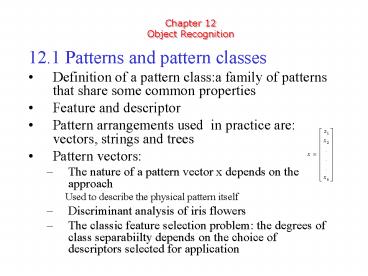12'1 Patterns and pattern classes PowerPoint PPT Presentation
1 / 20
Title: 12'1 Patterns and pattern classes
1
Chapter 12 Object Recognition
- 12.1 Patterns and pattern classes
- Definition of a pattern classa family of
patterns that share some common properties - Feature and descriptor
- Pattern arrangements used in practice are
vectors, strings and trees - Pattern vectors
- The nature of a pattern vector x depends on the
approach - Used to describe the physical pattern itself
- Discriminant analysis of iris flowers
- The classic feature selection problem the
degrees of class separabiilty depends on the
choice of descriptors selected for application
2
Chapter 12 Object Recognition
3
Chapter 12 Object Recognition
4
- Noisy object and its corresponding signature
- Select the descriptors on which to base each
component of a pattern vector - Pattern characteristics are described by
structural properties - For example fingerprint recognition based on
minutiae - Pattern classes are based on quantitative
information size and location - Features based on spatial relationships abrupt
ending, branching, merging, and disconnected
segments - Strings pattern problem a staircase pattern
- This pattern could be sampled and expresses in
terms of a pattern vector - The basic structure would be lost in the method
of description - Resol define the elements and b and let the
pattern be the string of symbols w.abababab - String descriptions generate patterns of objects
5
- Other entities whose structure is based on the
relatively simple connectivity of primitives,
usually associated with boundary shape - Hierarchical ordering leads to tree structures
- For example a satellite image
- based on the structural relationship composed
of
6
Chapter 12 Object Recognition
7
Chapter 12 Object Recognition
8
Chapter 12 Object Recognition
9
12.2 Recognition base on Decision- theoretic
methods
- Decision functionsthe property of class belong
to wi - di(x) gt dj(x) j1,2,,W j?i
- Decision boundary separating class wi from wj
- di(x)- dj(x)0
- 12.2.1 Matching
- Represent each class by a proto-type pattern
vector - Minimum distance classifier
- Define the prototype class to be the mean vector
of the patterns of that class - Determine the class membership of an unknown
pattern vector x is to assign it to class of its
closet prototype - Use Euclidean distance to determine closeness
computing the distance measures
10
Chapter 12 Object Recognition
11
Chapter 12 Object Recognition
12
Chapter 12 Object Recognition
13
- Assign x to class wi if Di(x) is the smallest
distance the best match - Selecting the smallest distance is equivalent to
evaluating the functions - the decision boundary between class wi and class
wj for a minimum distance classifier is - Matching by correlation
- The correlation between f(x,y) and w(x,y) is
- Disadvantage sensitive to changes in the
amplitude of f and w - Resol performing matching via the correlation
coefficient - Obtaining normalization for changes in size and
rotation can be difficult - Add a significant computation
- 12.2.2 Optimum statistical classifiers
- A probabilistic approach to recognition
- Become important because of the randomness which
pattern classes normally are generated
14
Chapter 12 Object Recognition
15
- Foundation
- The probability that a particular pattern x comes
from class wi - The average loss incurred in assigning x to class
wj - Rewrite the average loss as
- Drop 1/p(x), the average loss reduces to
- The Bayes classifier the classifier that
minimize the total average loss - Assign an unknown pattern x to wj if rj(x) lt
rj(x) - Loss of unity for incorrect decision and a loss
of zero for correct decision - A pattern vector z is assigned to the class whose
decision function yields the largest numerical
value
16
- Bayes classifier for Gaussian pattern classes
- The Bayes decision function have the form
- If the two classes are equally likely to occur
- P(W1)P(W2)1/2
- The Gaussian density of the vectors in the j-th
pattern class has the form (12.2-19) - Mean and co-variance matrix (12.2-22,, 12.2-23)
- If all the covariance matrices are equal, then
CjC, we obtain (12.2-27) linear decision
functions (hyper-plane) - If CI, p(wj)1/W, for j1,2,,W, then dj(x)
(12.2-28)
17
Chapter 12 Object Recognition
18
Chapter 12 Object Recognition
19
Chapter 12 Object Recognition
20
Chapter 12 Object Recognition

